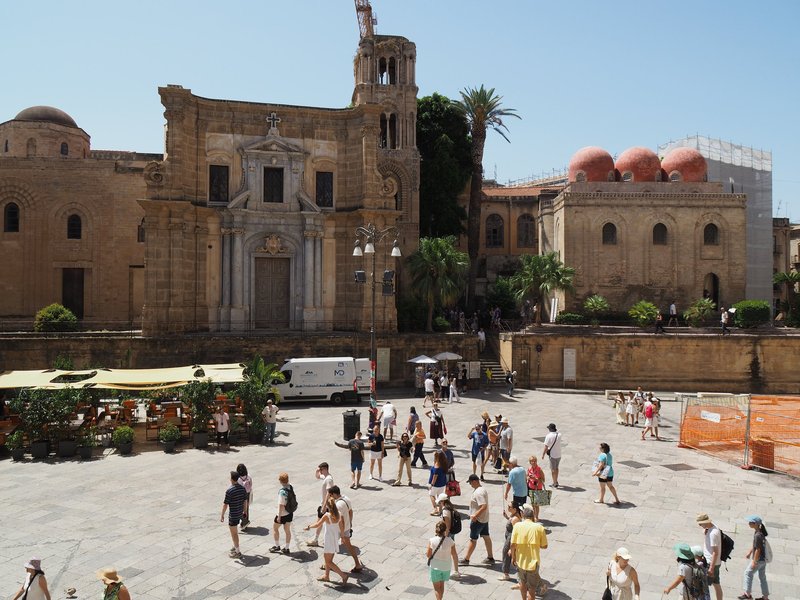marc Rouserez 3.0
Arab-Norma Palermo and the cathedrals of Cefalu and Monreale
Arab-Norman Palermo (Inscribed)
I had kept something up my sleeve in Palermo to make sure I caught the night ferry to Tunisia at the right time.
I stopped in Cefalu, about seventy kilometers from Palermo, with Wilson the mobile home with the aim of visiting its duomo the next day, and then going to Palermo to visit other sites of the Arab-Norman serial UNESCO heritage site.
In Cefalù, I parked discreetly in the large car park of the Hotel Santa Lucia, some distance from the town centre. This is the good thing because when you walk there, the town gradually reveals itself, with a beautiful view of the cathedral, the village and the Mediterranean (the introductory photo).
This cathedral, like the other properties in the list, has the particularity of bringing together different cultures of the 12th century AD: Western, Byzantine and Islamic, which seems unique to me. After admiring the main façade of the monument and once I entered the nave, the beauty of the mosaics in the apse amazed me: Christ Pantocrator and the secondary figures (especially angels) are fascinating in their majesty and harmony. Could we, as a fusion of cultures, consider this cathedral as a symbol of tolerance on the part of the Norman king Roger II, its builder? Or is it the expression of an ego that wanted to bring together the most skilled architects and craftsmen of his time on the site of his future burial? I don't know, but today I was delighted.

It was my second time in Palermo, having already visited it 40 years ago with my parents!
In a mobile home, you need nerves of steel to find a suitable parking space, but in the end, a dearly paid space was found along the Foro Italico Umberto 1, near the marina.
One day is not enough to visit all seven of the Palermo sites that make up the serial site. I was content to visit: San Cataldo and La Martorana, the cathedral, and the exterior of the Palazzo Reale because 40 years ago I had already visited the breathtaking Palatine Chapel and the quiet but no less beautiful San Giovanni degli Eremiti. At the time, we also went up to Monreale, which I have an unforgettable memory of, as do the catacombs.
Going up from the popular district of Kalsa, you can start by visiting San Cataldo and La Martorana, which visually appear as one on Piazza Bellini. Don't hesitate to climb the few steps of Palazzo Pretorio to get an overview (see photo). Don't hesitate to spend a few euros to see the interior of San Cataldo, which is a haven of peace. For the record, the red color of the domes is not medieval, but modern. La Martorana was closed, which is a shame. The bell tower of the church of La Martorana is Gothic (14th century). Inevitably, it reminded me of the cathedral of Laon, in the Aisne, one of the most beautiful in France (12th century too, like the primitive part of the church, by the way!). I wouldn't have been surprised to see sculpted oxen behind the pinnacles.

Then, taking Via Vittorio Emanuele, the cathedral. In this sense, what is a little strange is that we approach it by first seeing the façade from the chevet side, but so much the better because it is a pure splendor of syncretism between Norman and Islamic art. For those who would extend their trip to Tunisia, the main façade which overlooks Piazza Cattedrale and the chevet visible from Place Sett Angeli already give a faint glimpse of Aghlabid art (Art present in the Great Mosque of Kairouan, La Zituna in Tunis...).

And continuing along Via Vittorio Emanuele, you reach the Bonanno Garden and the Palazzo Reale, which houses the Palatine Chapel. As a side note, 40 years ago, I had to swap my shorts for my father's trousers to be able to visit the chapel! A word to the wise... bring decent clothes. I walked around it to get to the entrance of the Chiesa di San Giovanni Eremiti. Note that on the corner of the street, there is a theater named Franco Cuticchio where you can watch an Opera dei pupi, a performance of puppets listed as intangible cultural heritage. Then I completed the loop by passing by the Chiesa del Gesu, which is not part of the serial properties, but is worth seeing for those who love baroque crème fraîche and chubby cherubs!
More on
Comments
No comments yet.
